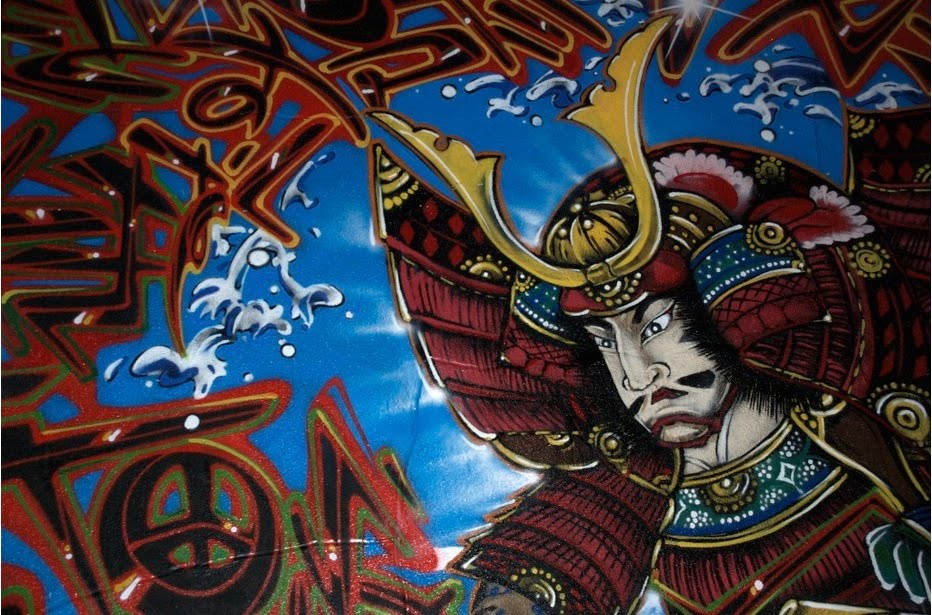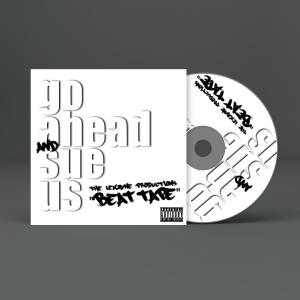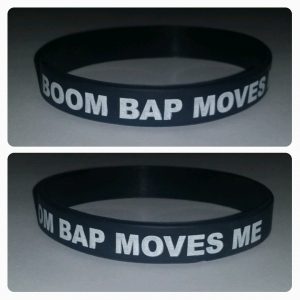The International Movement – Hip Hop In Japan

So I was in Sportie LA in Los Angeles, Ca. looking for a new pair of kicks, I think I went with a black and grey Air Huarache, when I noticed how a few of the store employees were waiting on one cat hand and foot. It wasn’t really a big deal until he pointed at the kicks I was test driving and said “kore o kudasai”. At that moment, being a “silly American”, I nodded and kept stepping. Not long after that the people helping him disappeared into the back of the store. 20 minutes or so passed and when they came back to the front it looked like they had the entire stockpile of every shoe in hand. It took about another 5 minutes orso for them to separate and count everything before ringing him up to a multiple thousand dollar bill. In those stacks of shoes I saw a box of Air Huarache’s. I payed closer attention and noticed not only did he have the same black and grey Huarache’s that I had, but he had every color that the store carried. It was the same for every other shoe that he tried on. He walked out with all the colors.
This sparked my interest in the Hip Hop culture and how it has spread to and in Japan. What better way to find out than look? So I started looking…
 Although rather informal and small scale, the early days of Japanese hip-hop provide the history for the emergence of the cultural movement. Early hip-hop was not led by corporate interests, but rather was largely ignored by large record companies and performance venues. In this respect, Japanese hip-hop offers a representation of cultural globalization, as it expanded despite criticism on the part of record companies and major media outlets. The history shows that certain kinds of cultural exchange are not initiated through cultural understanding, but instead from some interaction that can incite a desire to learn, to participate, and to contribute individuality. In Japan, this motivation to represent individuality was breakdancing, which was one of the leading edges of hip-hop at the time.
Although rather informal and small scale, the early days of Japanese hip-hop provide the history for the emergence of the cultural movement. Early hip-hop was not led by corporate interests, but rather was largely ignored by large record companies and performance venues. In this respect, Japanese hip-hop offers a representation of cultural globalization, as it expanded despite criticism on the part of record companies and major media outlets. The history shows that certain kinds of cultural exchange are not initiated through cultural understanding, but instead from some interaction that can incite a desire to learn, to participate, and to contribute individuality. In Japan, this motivation to represent individuality was breakdancing, which was one of the leading edges of hip-hop at the time.  An important spark for Japanese hip-hop occurred in 1983, when breakdancing appeared in Tokyo through film and live performances even though American hip hop records could previously be heard in Tokyo discos. According to Takagi Kan, a first generation Japanese MC, “I couldn’t tell what was with the rap and the DJing…but with the breakdancing and graffiti art, you could understand it visually. Or rather, it wasn’t understanding so much as, ‘Whoa, that’s cool’ [kakoii]. With rap and DJing, I couldn’t imagine what could be cool about it.” Dancing has a visual impact that everyone can understand, when it comes to dance there is not a language barrier. Break dancing represented the foundation for the spread of Japanese hip-hop and served as a medium for globalization.
An important spark for Japanese hip-hop occurred in 1983, when breakdancing appeared in Tokyo through film and live performances even though American hip hop records could previously be heard in Tokyo discos. According to Takagi Kan, a first generation Japanese MC, “I couldn’t tell what was with the rap and the DJing…but with the breakdancing and graffiti art, you could understand it visually. Or rather, it wasn’t understanding so much as, ‘Whoa, that’s cool’ [kakoii]. With rap and DJing, I couldn’t imagine what could be cool about it.” Dancing has a visual impact that everyone can understand, when it comes to dance there is not a language barrier. Break dancing represented the foundation for the spread of Japanese hip-hop and served as a medium for globalization.
 As in Germany, Japan was introduced to hip hop in the fall of 1983 in the movie Wild Style. The film is “the classic hip-hop flick, full of great subway shots, breakdancing, freestyle MCing and rare footage of one of the godfathers of hip-hop, Grandmaster Flash, pulling off an awesome scratch-mix set on a pair of ancient turntables”. The popularity of the film led to many of the artists involved in it to make a trip to Japan to promote the film and they even performed in some of the department stores while they were there. Shortly after, Japanese took up breakdancing in Tokyo’s Yoyogi Park, where street musicians gather every Sunday to perform. Crazy-A, now the leader of Rock Steady Crew Japan,” was one of the pioneers of break dancing in Yoyogi back in the early 1984″. Crazy-A organizes the annual “B-Boy Park,” which happens every August, and draws a large number of fans and dozens of break dancing groups. This was all considered the Old School Era of rap in Tokyo. There was much of what they called Soul Dancing, which helped the Japanese culture accept the street dance culture.
As in Germany, Japan was introduced to hip hop in the fall of 1983 in the movie Wild Style. The film is “the classic hip-hop flick, full of great subway shots, breakdancing, freestyle MCing and rare footage of one of the godfathers of hip-hop, Grandmaster Flash, pulling off an awesome scratch-mix set on a pair of ancient turntables”. The popularity of the film led to many of the artists involved in it to make a trip to Japan to promote the film and they even performed in some of the department stores while they were there. Shortly after, Japanese took up breakdancing in Tokyo’s Yoyogi Park, where street musicians gather every Sunday to perform. Crazy-A, now the leader of Rock Steady Crew Japan,” was one of the pioneers of break dancing in Yoyogi back in the early 1984″. Crazy-A organizes the annual “B-Boy Park,” which happens every August, and draws a large number of fans and dozens of break dancing groups. This was all considered the Old School Era of rap in Tokyo. There was much of what they called Soul Dancing, which helped the Japanese culture accept the street dance culture.
The rise of DJs was really the next step for the Japanese hip hop scene. Before 1985, there weren’t very many DJs on the radio, but with the increase in the number that year, it led to the opening of the first all hip hop club in 1986. But despite the fact that DJing caught on rather quickly, it was initially thought that rapping wasn’t going to have the same cache as it would be hard to rap in Japanese.
Street musicians began to breakdance in Yoyogi Park, including DJ Krush who has become a world-renowned DJ after arising from the Yoyogi Park scene. In 1986 an all hip hop club opened in Shibuya. While interest in hip-hop in Japan grew some during the 1980s and early 1990s, the rap scene remained fairly small and rather marginalized. One reason for the rap scene to remain so small and a little bit less popular compared to hip hop is because of the fact that the Japanese language does “not contain stress accents and sentences must end with one of a few simple verb endings.” Ito Seiko, Chikado Haruo, Tinnie Punx and Takagi Kan were rappers that emerged out of Japan at this time, and they proved to be rather successful.
The years 1994 and 1995, marked the beginning of hip-hop’s commercial success in Japan. The first hit was Schadaraparr’s “Kon’ya wa būgi bakku” (Boogie Back Tonight) by Scha Dara Parr and Ozawa Kenji, followed by East En X Yuri’s “Da. Yo. Ne.” and “Maicca,” which each sold a million copies. This sudden popularity of J-rap, which was largely characterized as party rap, sparked a debate over ‘realness’ and authenticity between commercial and underground hip-hop artists. “Keep It Real” is definitely a global campaign.
An example of an underground attack on mainstream J-Rap is Lamp Eye’s “Shogen,” in which rapper You the Rock disses the more pop oriented group Dassen Trio. Writer Ian Condry argues that the rappers on this track are closely emulating the traditional macho posturing of rap, citing influences such as Public Enemy and Rakim. The video reflects this image in its roughness and tone Dassen Trio, and other pop rappers, respond to such attacks with the argument that their subject matter is more culturally appropriate and accessible for Japanese fans, and question the standards of “realness” put forth by underground rappers.
With a lack of ghettos, Japanese youth consider hip hop the soundtrack to international fashion–baggy jeans, medallions, dread locks etc. Actual Japanese rap lyrics have a tendency to refer to mundane subjects such as food, cell phones, and shopping. Since 2000, the hip hop scene in Japan has grown and diversified. Hip-hop style and Japanese rap has been enormously commercially successful in Japan. In a 2003 interview with the BBC, Tokyo record-store owner, Hideaki Tamura noted “Japanese hip-hop  really exploded in the last two, three years. I never thought there would be a time when Japanese records could outsell American ones but it’s happening.” Additionally, a huge number of new scenes have developed. These include “rock rap to hard core gangsta, spoken word/poetry, to conscious, old school, techno rap, antigovernment, pro-marijuana, heavymetal-sampled rap, and so on.” Tamura points to a shift in Japanese hip hop, when artists began to focus on issues pertinent to Japanese society, versus previous styles and subjects that were copied from US hip hop culture. For Japan, the style of hip hop was much more appealing than topics popular in American hip hop, such as violence. Ian Condry, on the other hand, focuses on an interplay between local and global hip hop within the genba of Japan. For Condry, Japanese hip hop was born out of simultaneous localization and globalization of hip hop culture, rather than a shift between the two binary factors.
really exploded in the last two, three years. I never thought there would be a time when Japanese records could outsell American ones but it’s happening.” Additionally, a huge number of new scenes have developed. These include “rock rap to hard core gangsta, spoken word/poetry, to conscious, old school, techno rap, antigovernment, pro-marijuana, heavymetal-sampled rap, and so on.” Tamura points to a shift in Japanese hip hop, when artists began to focus on issues pertinent to Japanese society, versus previous styles and subjects that were copied from US hip hop culture. For Japan, the style of hip hop was much more appealing than topics popular in American hip hop, such as violence. Ian Condry, on the other hand, focuses on an interplay between local and global hip hop within the genba of Japan. For Condry, Japanese hip hop was born out of simultaneous localization and globalization of hip hop culture, rather than a shift between the two binary factors.

Previous to the inception of hip hop, soul dancing became popularized in Japan in the 1970s. Shows like ‘Soul Train’ spread the African-American style of on-going dance that would soon be picked up by varying cultures all over the world. It is this style of dance that laid the foundation for the globalization of African-American culture due to its universal criteria. Anyone can dance to soul music, which is not the case in terms of rapping, b-boying, etc. As movies like ‘Flashdance’ (1983) reached the islands, more and more young people began dancing on the street and other public arenas, which added to its cultural integration. Soon, Japanese culture was ready to alter the very structure of their language in order to partake in hip hop.
Hip hop was thought to have originally become popular in Japan because the Japanese people wanted to imitate African-Americans. The Japanese would hear these rapper’s music spinning in clubs, exposing to them a small, narrow view of West Coast hip hop. It was not the only music they latched onto, however. They came to love the entire hip hop culture, including the loose-fitting clothes, graffiti writing, and break dancing. Some Japanese hip-hop fans would even go to tanning salons to darken their skin, and style their hair in afros or dreadlocks to imitate the “cool” looks of African-Americans,although they are ridiculed by others, including other hip-hoppers.

Not surprisingly, Japan has many emcees and groups that exemplify both local and global culture, as they see it, in their music. The “machine” has reached the far east and had similar effects on hip hop there as it has had back in the states.
Rhymester

One major Japanese hip hop group, Rhymester, has expressed opinions on various global and philosophical issues through their lyrics. Rhymester has put out motivating messages through hip hop, with songs like “B-Boyism” that emphasizes improving oneself, with lyrics such as “I’m not surrendering this aesthetic flattering no one, I improve myself only the wonderful, useless people get it, and roar, at the edge of the bass.” The group has also written socially critical lyrics, in songs attacking the Japanese government, as well as the United States for invading Iraq.Rhymester is also known for its collaborative work with the Funky Grammar Unit in the 1980s, as well as its participation in hip hop battles.
[yframe url=’http://www.youtube.com/watch?v=gQYx3hXsLWk’]
King Giddra
Another major group of Japanese hip-hop is King Giddra. They are one of the few pioneers of Japanese hip-hop. They began their hip hop careers in 1993 and felt hip-hop was needed in Japan. Group members, Zeebra and K Dub Shine, both of whom had lived in the U.S., were convinced of the necessity for hip-hop to be about issues of social opposition.They used hip-hop to address social issues of the time, such as: the inability of college graduates to find employment and the media overload of advertising sex and violence. They also “challenged youth not only to recognize the difficulties faced by Japanese society but also to speak up about them.” Their first album has been cited as being influential in the development of rapping style in Japanese.
[yframe url=’http://www.youtube.com/watch?v=jhJ7jCMuaqw’]
Dabo

Dabo is one of the first hip hop artists in Japan. He sprung to the scene in the 1990s and has fame all over Japan. He is the first Japanese artist to be signed to Def Jam Japan. However, he is disliked by some in Japan for his style of hip hop, which is said to be imitation of African American Hip Hop.
[yframe url=’http://www.youtube.com/watch?v=Daf8LnrNajI’]
Hime

Hime is a very influential female emcee in Japan. In her music, she employs a strong message to empower women in Japanese culture. Many of her songs combat the common stereotype of women in Japanese culture. She calls herself “the voice of the Japanese doll,” in attempts to challenge and reinvent stereotypes that label women as quiet and obedient. Another common stereotype used to degrade women in Japan is the term yellow cab, which is used to describe a woman who is sexually provocative or whorish. In her song, Yellow cab, Hime cleverly deconstructs the derogatory connotations of this term. By contextualizing yellow cab as defining a woman who is in the driver’s seat, Hime transforms its meaning in attempts to empower Japanese women. Hime has revolutionized the rhyming patterns in rap songs by embracing traditional Japanese poetic forms such as tanka in her song “If the Peony Stands.” In her use of this intricate form, she embraces and fuses Japanese culture with traditional American hip hop styling.
[yframe url=’http://www.youtube.com/watch?v=OUcQUBnzpjk’]
The Japanese have fully adopted hip hop as a culture and adapted it to fit what they feel, see, and live. Any and every culture evolves over time and for something as great and influential as hip hop, it’s a given that it will continue to reach into every corner of the world. It is a strong factor in Japan and will definitely influence Japans future and the Japanese culture as a whole.
Related posts:
There is one comment on The International Movement – Hip Hop In Japan
Leave a Reply Cancel reply
Cart
Products
-
 Go Ahead And Sue Us - Beat Tape (Tester)
Go Ahead And Sue Us - Beat Tape (Tester)
$5.00$0.00 -
 Go Ahead And Sue Us - Beat Tape
Go Ahead And Sue Us - Beat Tape
$5.00$0.00 -
 Silicone Wristband
$2.00
Silicone Wristband
$2.00
-


See “Sum N One” new video “DAT YEN” on Youtube. Check out “SUM N ONE” on Facebook.
PASS IT ON.
GREAT VIDEO, WOW